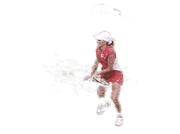The Serve: Where Are We Now?
The Women
John Yandell
In the last two articles we have focused on the commonalities in high level serves (Click Here) and on the differences (Click Here.) All the examples have been men.
So in this article let's look closely at some elite women. Serena Williams, Maria Sharapova, Sam Stosur, and Justine Henin. All were very effective servers.
After the first two articles I got some emails asking why I hadn't chosen any women for the models. And the answer is that as effective as these women are or were, we can find technical flaws in all their motions—with the exception of Justine who I will address at the end.
Still I am adding the women examples to the Side by Side section of the site for those who want to study these players more closely. (Click Here.)
Core Positions
If you recall the core elements in good serving there are 3 positions in the upward and outward swing: the racket drop, the contact point, and the extension.
Starting with the drop we see all these women make that position. The racket either falls along the right side like Maria and Serena. Or swings a little to the outside like Sam.
Sam's drop shows she rotates her arm backwards in the shoulder joint further than the other two. This is similar to Andy Roddick on the men's side.
All three players also hit the contact point similar to the men. This is with the elbow extended but with the racket head tilted somewhat to the left. More to the left for Sam.
This position as we have seen many times indicates that their first serves have a topspin component, with Sam's probably having the most.
Extension
But the third position, the extension of the motion, is where you see some differences. With the great men's servers you see the hand racket and arm rotate about 90 degrees after contact so the edge of the racket is basically perpendicular to the court.
The men in general make this position on all serves. This means to both corners in both boxes.
It's true for Sam, she rotates fully. But sometimes it's incomplete for Serena. And sometimes Maria makes it but sometimes she doesn't come close.
Why is that important? Doesn't mean you can't hit a really good serve without it. But that rotation shows that the racket speed is maximized because the upper arm has continued to rotate in the shoulder joint.
This rotation is the number one source of racket speed. Technically it's called internal shoulder rotation. If it is slowing down or stopping after contact, it makes sense that it isn't maximized at contact.
Stances
All three of these women are using some version of a pinpoint stance. And all three have great knee bend and are pushing with both feet. Dr. Ben Kibler finds that this push is a big key in high level serving. (Click Here.)
But as we have also seen many times, the pinpoint limits the amount of body rotation away from the ball in the windup and then forward to the ball. Amd. as we've seen in the previous articles that might not matter if you are John Isner.
And again, these women are all hitting great serves. But if you look at Sam, Serena, and Maria you see they get at most a few degrees of rotation away from the ball.
The stance and the body turn are technical factors for men like Roger Federer and Novak Djokovic. And greats like Pete Sampras and John McEnroe have incorporated more extreme versions. But I believe at least some body turn can make a big positive contribution at any level.
Early Entry
When we look at the leg drive of these 3 women, I see another technical flaw or limitation compared to the men. This is something the great biomechanist Brian Gordon first pointed out to me.
He calls it early entry into the backswing. Research shows that the leg drive adds racket speed by pushing the racket downward toward the drop.
The timing of this is critical. The push with the legs should start with the racket at or near the trophy position.
The impact is significantly reduced however if the racket enters the drop before this. And this is what we see with our three servers.
At the time the push is ready to begin, they all have early entry with the racket past the trophy position and starting downward toward the drop. Again, it's not the end of the world, but it's another factor that isn't maximized.
For all of the above are reasons I wouldn't pick these 3 women for models. This is true for working with high level players and I believe recreational and NTRP players as well.
Justine
Which brings us to Justine Henin. When I first filmed her in 2002 at Indian Wells, her serve was closer technically to the other women with an even more extreme pinpoint stance, a slight early entry, and limited body turn. She was really struggling with it and I saw her hit something like 12 double faults in one match.
I knew her coach at the time Carlos Rodriquez and he knew about our high speed filming from the 1997 U.S. Open. I shared the footage of the Sampras serve with him and he believed he could reconstruct her serve on the Sampras model.
He was right. He did. At the time she had not won a Grand Slam, but she went on to win 7 Slam titles in the next 6 years. To read the whole story, Click Here.)
To me this was conclusive proof that women or any player could learn to serve with a better technical model. So what did Justine's new serve look like technically?
She altered her starting stance, moving her back foot further backwards and to her left. This allowed her to turn away from the ball in the wind up.
It eliminated the slight early entry. And like Pete she now had amazing hand, arm, and racket rotation early in the extension—an indication of increased racket speed at contact.
So obviously Carlos did an amazing job with a willing player. But he didn't stop there. He also made a big improvement on her forehand, again using our high speed footage, this time with Andre Agassi as the model. (Click Here.)
It's all a testament to the power of high speed imagery in coaching. I know from years of experience that same process will work at any level.
Few lower level players, if any, can change their serves to the extreme Sampras model, but most if not all can add some version of a platform stance, get more body rotation, get the correct timing on entry into the backswing, and learn to fully rotate the racket and arm to extension. Men and women.




